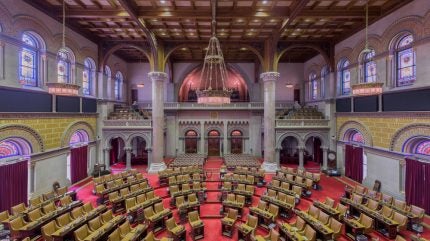
A new analysis finds opponents of New York’s Packaging Reduction and Recycling Infrastructure Act outnumbered supporters by four to one during this year’s legislative session, helping derail the measure in the state Assembly despite its earlier passage in the Senate.
The report by environmental group Beyond Plastics, released on 7 October, counted 107 companies and organisations lobbying against the extended producer responsibility (EPR) packaging bill, compared with 23 in support.

Discover B2B Marketing That Performs
Combine business intelligence and editorial excellence to reach engaged professionals across 36 leading media platforms.
What the packaging reduction and recycling infrastructure act would do
The bill—known by supporters as PRRIA—would require companies with more than US$5 million in annual revenue to cut the amount of packaging they place on the market by 30% over 12 years.
It would prohibit certain chemicals in packaging, including substances flagged by public-health advocates, and impose modulated fees tied to the recyclability and toxicity of materials.
Proceeds would be used by local authorities to maintain and upgrade recycling infrastructure. The Senate advanced the measure during the spring; the Assembly did not bring it to a final vote before adjourning in June.
Industry groups say costs would rise; advocates cite taxpayer savings
Major brands and trade associations, among them Amazon, Kraft Heinz, Coca-Cola and the Business Council of New York State, argued the bill’s material bans and reduction mandates would increase costs and restrict consumer choice.

US Tariffs are shifting - will you react or anticipate?
Don’t let policy changes catch you off guard. Stay proactive with real-time data and expert analysis.
By GlobalDataEnvironmental groups counter that EPR shifts disposal costs from households to producers and could deliver municipal savings by reducing landfill and incineration volumes.
Earlier modelling cited by supporters estimates potential statewide savings of about US$1.3 billion over a decade, though exact impacts would depend on final fee levels and implementation.
Lobbying landscape in Albany underscores 2026 fight
Because New York does not require bill-by-bill lobbying disclosures, spending totals reflect organisations’ overall outlays across issues.
Even so, filings reviewed by the Times Union indicate opponents collectively spent about US$9.8 million during the session, compared with roughly US$1.5 million by supporters.
Advocates say they will return in 2026 with an emphasis on taxpayer savings and public-health aspects, while business groups signal continued resistance unless the proposal is narrowed.
Independent outlets and official trackers confirm the bill remains active for consideration next year.





